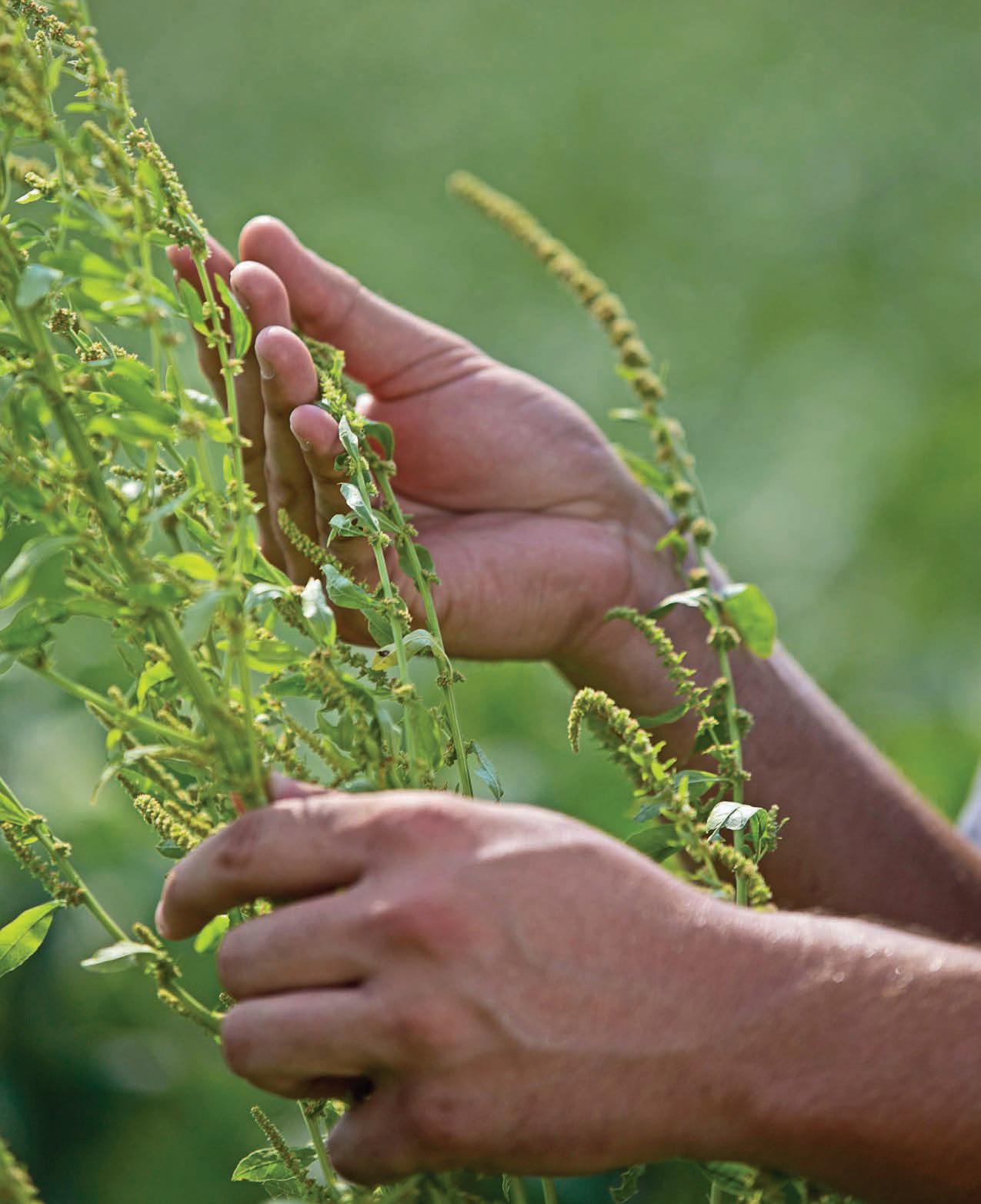




















From researching new uses for soybeans to identifying new markets for U.S. soy, the soy checkoff is working behind the scenes to create new opportunities and increase profits for soybean farmers. We’re looking inside the bean, beyond the bushel and around the world to keep preference for U.S. soy strong. And it’s helping make a valuable impact for soybean farmers like you.
See more ways the soy checkoff is maximizing profit opportunities for soybean farmers at unitedsoybean.org






COVER STORY: It’s no secret – 2019 had one of the worst planting seasons in recent memory. Ohio had 1,485,919 prevent plant acres, which caused some fields to experience an increase in the weed seed bank. Pre- and postherbicide applications were delayed, or never happened at all. Because of that, weed control could be a challenge in 2020. Mark Loux, The Ohio State University Extension weed scientist, lets you know the best way to combat the potential weed issues posed by 2019 prevent plant on page 18.

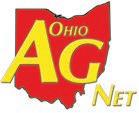


ARyan Rhoades
Ohio Soybean
Association President
Marion County soybean farmer
s I write this, the world is experiencing a global pandemic that has altered our daily lives in ways we’ve never seen before. The situation is changing daily, and none of us really know what it will be like when this letter reaches you. No matter the situation, I hope you and your families remain safe and healthy.
It’s hard not knowing exactly how and when we’re going to come out of the lockdowns, school closures, and daily worry about the health of our loved ones. What I’ve found comfort in is a piece of advice I remember my grandfather and father giving me when I was about nine years old.
Don’t panic, they told me. No matter what’s going on around you, panicking is the worst thing you can do. We have a responsibility to put one foot in front of the other, one day at a time, and continue to move forward even in a crisis. I want to model this to my children as well. They are sponges and will pick up on our stress and negativity. If I panic, they will panic. I want to show them my resolve and optimism instead.
Agriculture and the work we do is one of the most essential of essential businesses and we are continuing to move forward. Farmers are getting ready to plant, seed companies are moving supplies, and the food supply chain is adjusting to our new temporary normal.
I see this sentiment reflected in the work of our farm organizations as well. The Ohio Soybean Association continues to meet remotely, and our staff is maintaining contact with our legislative leaders on a wide variety of policy issues. The Ohio Soybean Council and soybean checkoff continues its vital work in market development, research, and education. Your farmer leaders are making strides to achieve our goals and provide support to Ohio farmers.
Thanks to the lessons I learned from my grandfather and father, I know that we’ll get through this together one step at a time. I also wish all of you a safe and healthy planting season.

Ryan Rhoades OSA President Marion County
President
Ryan Rhoades, Marion County
First Vice President
Patrick Knou , Shelby County
Vice President
Jennifer Wilson-Oechsle, Van Wert County
Treasurer
Je McKanna, Hancock County
Secretary
Rusty Goebel, Williams County
Chairman
Scott Metzger, Ross County
Trustees
Jerry Bambauer, Auglaize County
Trish Cunningham, Knox County
Bret Davis, Delaware County
Caitlyn Heimerl, Industry A liate Ex-O cio
Je Magyar, Ashtabula County
Derek Reusser, Holmes County
Andy Stickel, Wood County
Kerrick Wilson, Preble County
American Soybean Association
Board Representatives
Jerry Bambauer
Bret Davis
Scott Metzger
Staff Credits
Kirk Merritt - Publisher
Jennifer Coleman - Editor
Julia Brown - Contributing Editor/Sta Writer
Brent Warren - Art Director
Barry Falkner - Photo Quality/Proofer
Tony Green - Advertising Production
Ohio Soybean news is published six times a year by the Ohio Soybean Association, 918 Proprietors Rd., Suite A, Worthington, OH 43085. Phone: 614-476-3100. For address corrections contact Ohio Soybean News at 918 Proprietors Rd., Suite A, Worthington, OH 43085.
Web address: www.soyohio.org E-mail: cdeboard@soyohio.org
Comments and statewide news articles should be sent to the above address. Advertising space reservation must be made by the rst of the month preceding publication. In consideration of the acceptance of advertisement, the agency and the advertiser must, in respect of the contents of the advertisement, indemnify and save the publisher harmless against any expense arising from claims or actions against the publisher because of the publication of the content of the advertisement.
For Advertising Sales Contact: Matt Herman - (612) 812-5833
matt.herman@dtn.com


The Ohio Soybean Association (OSA):
Strongly supports implementation of the 4R concept of nutrient management – Right Source, Right Rate, Right Time, Right Place.
Supports policies backed by science and research-based discoveries that create practical regulations and avoid undue financial burdens.
Supports funding to further voluntary, science-based programs to improve water quality.
Supports allowing current policies and regulations the time needed to achieve expected outcomes.
Ohio Department of Higher Education: Supports full funding for Land Grant Universities, including The Ohio State University Extension, the Ohio State University. Agricultural Research and Development Center, and the Sea Grant and Stone Laboratory at Lake Erie.
Ohio Department of Natural Resources: Supports continued funding for the Clean Lake Erie Fund and continued funding to be utilized for feasible practices to reduce phosphorus in Lake Erie.
Ohio Department of Agriculture: OSA supports funding the Department needs to fulfill their required duties.
Fuel Quality Standards Funding: Supports full funding for the development and implementation of a fuel quality standards program.
Ohio Department of Education: Supports agriculture education programs in and outside of the classroom.
Supports efforts to increase broadband access to rural Ohio in

order to help improve quality of life and create strong and competitive farming operations.
Supports trade and vocational education that promotes agribusiness jobs.
Supports efforts to increase access for energy and infrastructure projects in rural Ohio.
Supports the usage of sustainable biodiesel by state vehicles and heavy equipment and encourages the Ohio Legislature to explore the impact of a biodiesel requirement or incentives on all fuel sold in Ohio.
Supports a minimum 10% biodiesel requirement in diesel fuel.
Supports and encourages the increased purchase and use of sustainable biobased products by state agencies.
Supports fuel quality standards to protect consumers from unknowingly purchasing substandard fuel to maintain the integrity of the fuel supply and protect the reputation of biodiesel as a high quality, high performing fuel.
OSA’s policy priorities help guide conversations between OSA board members and elected officials, like the one seen here between Williams County farmer Rusty Goebel and U.S. Rep. Bob Latta (5th District).
Supports timely and consistent inspections of bridges in rural areas, and adequate funding for bridge maintenance.
Supports higher truck weight limit implementation when research shows that increased limits are appropriate due to modern equipment and technology.
Supports resources allocated toward the upgrade of inland water systems and harbor management.
Encourages the state of Ohio to develop funding specifically for attracting and promoting food and agricultural companies to Ohio.
Encourages funding for beginning farmers through young farmer incentives such as loans from banks, farm credit associations, and other sources.
Encourages the State of Ohio to promote soybean markets, both domestically and abroad, through state officials and agency involvement. u


Held at the end of February in San Antonio, Texas, the 2020 Commodity Classic featured dozens of educational sessions, a huge trade show with nearly 400 exhibitors, a keynote address by U.S. Secretary of Agriculture Sonny Perdue, a wide variety of presentations from well-known industry leaders and top farmers, and tours of area attractions.
A record number of farmers converged on San Antonio for the

event. Total farmers registered was 4,678 — the highest number in the show’s 24-year history, eclipsing the previous record of 4,595 set in 2016 in New Orleans. Total registrations of 9,350 was also second only to the New Orleans event.
For most farmers attending Commodity Classic, it was a time to experience and learn new ways to improve farm operations. For farmers who were serving as voting delegates, however, Commodity Classic was a time to shape the priorities for policy and legislation for the American Soybean Association (ASA) for the coming year.
The following issues will remain important to ASA in 2020, with priority placed on farm economy, trade, infrastructure and biodiesel. To see a complete list of ASA’s policy resolutions, visit www.soygrowers. com/key-issues-initiatives/policyresolutions.

Voting delegates from Ohio included (left to right): Jeff McKanna (Hancock County); David Clark (Warren County); Jerry Bambauer (Auglaize County); Kerrick Wilson (Preble County); Ryan Rhoades (Marion County); Steve Reinhard (Crawford County); Bob Suver (Clark County); Rusty Goebel (Williams County); and Bret Davis (Delaware County)

Encourage efforts to increase demand for soybeans domestically and abroad. Support crop insurance as a risk management tool for farmers.
Achieve completion of the United States-Mexico-Canada Agreement (USMCA), removal of the China 301 tariffs and progress on new Free Trade Agreements (FTAs). Support an increase in funding for the Market Access Program (MAP) and Foreign Market Development (FMD) program.
Support investments in inland waterways infrastructure upgrades and deepening of the Mississippi River shipping channel.
Push for an increase in annual Renewable Fuel Standard (RFS) volumes for biodiesel and advanced biofuels; favorable implementation of the RFS, including small refinery waivers and antidumping measures.
Advance biotechnology, plant breeding innovation, and crop protection priorities within Congress and regulatory agencies.
Raise awareness of ongoing on-farm practices that improve soil health, reduce runoff, and improve water quality. u


hese two recently-introduced bills at the Statehouse and Capitol Hill have the potential to impact soybean farmers.
This bipartisan bill, co-sponsored by Rep. George Lang (R-West Chester) and Rep. Brigid Kelly (D-Cincinnati), would authorize county auditors in Ohio to implement motor fuel quality tests for octane levels and the presence of sediment and water.
Auditors across Ohio are required to inspect the pumps for leaks and to ensure they dispense a true gallon, but unlike Indiana and Kentucky and 45 other states, Ohio is one of just three states, including Alaska and Nebraska, that do not allow testing the quality of the fuel. HB 499 would allow each county in Ohio to decide whether to participate in the quality testing program.
“No county is forced to do it. It’s going to be up to the county to choose,” Lang said.
“We think this is the right step in the right direction for consumers and for families in our community,” Kelly added.
According to Kelly and Lang, the cost of implementing the program would be absorbed by the counties that choose to participate. New equipment to test the fuel for quality could cost
as much as $10,000, but there would be no need to hire additional inspectors since they can add the new testing to their list of inspections they already conduct.
The bill was introduced in February and assigned to the transportation committee. It hasn't yet received a hearing.
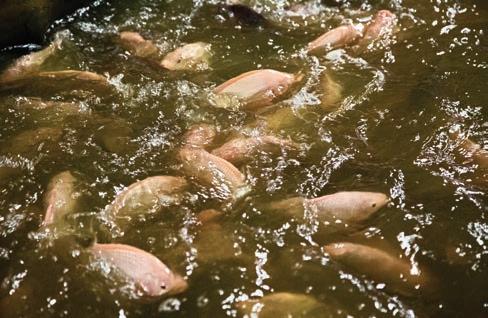
In March, U.S. Representatives Steven Palazzo (R-MS) and Collin Peterson (D-MN) re-introduced the “Advancing the Quality and Understanding of American Aquaculture Act," or the AQUAA Act.
The bill seeks to increase the United States’ involvement in the aquaculture industry by enabling its development in federal waters, which extend from 12 miles offshore through to 200 miles offshore.
The AQUAA Act would establish National Standards for sustainable offshore aquaculture and clarify a regulatory pathway for offshore aquaculture in the U.S. exclusive economic zone (EEZ) which will support growth of the domestic offshore aquaculture industry.

Regulated expansion of domestic aquaculture would stimulate economic growth in coastal and agricultural communities across the U.S., create thousands of jobs, and provide a steady supply of healthy and affordable seafood, while protecting
Ohio is one of just three states that do not allow testing the quality of the fuel. House Bill 499 could change that.
The AQUAA Act seeks to increase the United States’ involvement in the aquaculture industry by enabling its development in federal waters.
the country’s wild-capture fisheries and natural resources.
Increased aquaculture production would also benefit farmers of soybeans, corn and peas — products that would be used to create fish feed, easing pressure on ocean resources while providing a new market for U.S. farmers.
Major aquaculture-exporting nations include China, India and Vietnam. U.S. aquaculture — both freshwater and marine — supplies about 5% of the U.S. seafood supply, and U.S. marine aquaculture supplies less than 1.5%.
The American Soybean Association supports research on plant-based feeds to position soy as the economically viable and environmentally friendlier alternative to fish meal and fish oil. Since 1992, soybean farmers have funded market development activities for soy-based aquaculture diets, primarily in China. This program has increased demand for soybean meal for farm-raised fish from almost zero to an estimated 408 million bushels annually, contributing to China’s emergence as the largest market for U.S. soybean exports and soy’s role as the largest U.S. agricultural export. u







The 35th class of American Soybean Association (ASA) Corteva Agriscience™ Young Leaders completed their training Feb. 25–29, 2020, in San Antonio, Texas, in conjunction with the annual Commodity Classic Convention and Trade Show.
“The ASA Corteva Agriscience™ Young Leader Program helps provide the soybean industry and all of agriculture with strong and forward-thinking grower leaders,” ASA President Bill Gordon said. “The program focuses on leader development and emphasizes collaboration, providing us with growers who are working together to amplify the voice of the farmer. We are grateful to Corteva for their longstanding support of this program and for helping to secure the future of the soybean industry.”
While in San Antonio, the Young Leaders participated in training focused on leadership development, industry issue updates and outreach. The Young Leaders were also recognized at ASA’s annual awards banquet.
“Corteva has been a proud sponsor of the ASA Corteva Agriscience™ Young Leader Program for over 35 years. This program has a rich history of developing soybean growers from across the country and providing opportunities to strengthen their leadership skills and build their network in the agriculture industry,” U.S. Commercial Unit Leader Nate Miller said. “I have interacted with
Justin and Emily Esselburn from Lakeville (Wayne County)
this year’s class of Young Leaders and am excited about the positive impact these leaders will make on agriculture for generations to come.”
The 2020 Young Leaders are: Caper & Alison Robinson (AR); Jesse Patrick (GA); Brady Holst (IL); James Ramsey (IN); Eric Schwenke (IN); Noah & Anna Fedders (IA); Ryan & Kristin Oberbroeckling (IA); Jeremy Olson (KS); Houston & Katy Howlett (KY); Nathan Engelhard (MI): Allison Morse (MI); Mike & Dawn Kunerth (MN); Ryan Mackenthun (MN); Garrett & Cara Riekhof (MO); Josh England (NE); Lucas & Becky Miller (NE); Trey & Rebecca Liverman (NC); Justin Sherlock (ND); Justin & Emily Esselburn (OH); Scott Ruck (OH); Jesse King (SD); Drew & Lauren Peterson (SD); Casey Youngerman (TN); Adam & Brittany Davis (VA); Matt Rehberg (WI); and Chris & Rachel Renwick (Canada).
For more information about the ASA Corteva Young Leader Program visit SoyGrowers.com.

l Farm Credit Mid-America is proud to work with industry partners who share our purpose: to secure the future of rura communities and agriculture. As our industry evolves, we remain committed to supporting the Ohio Soybean farmers who grow, harvest and produce quality products today and in the future - just as we have for the past 100 years.



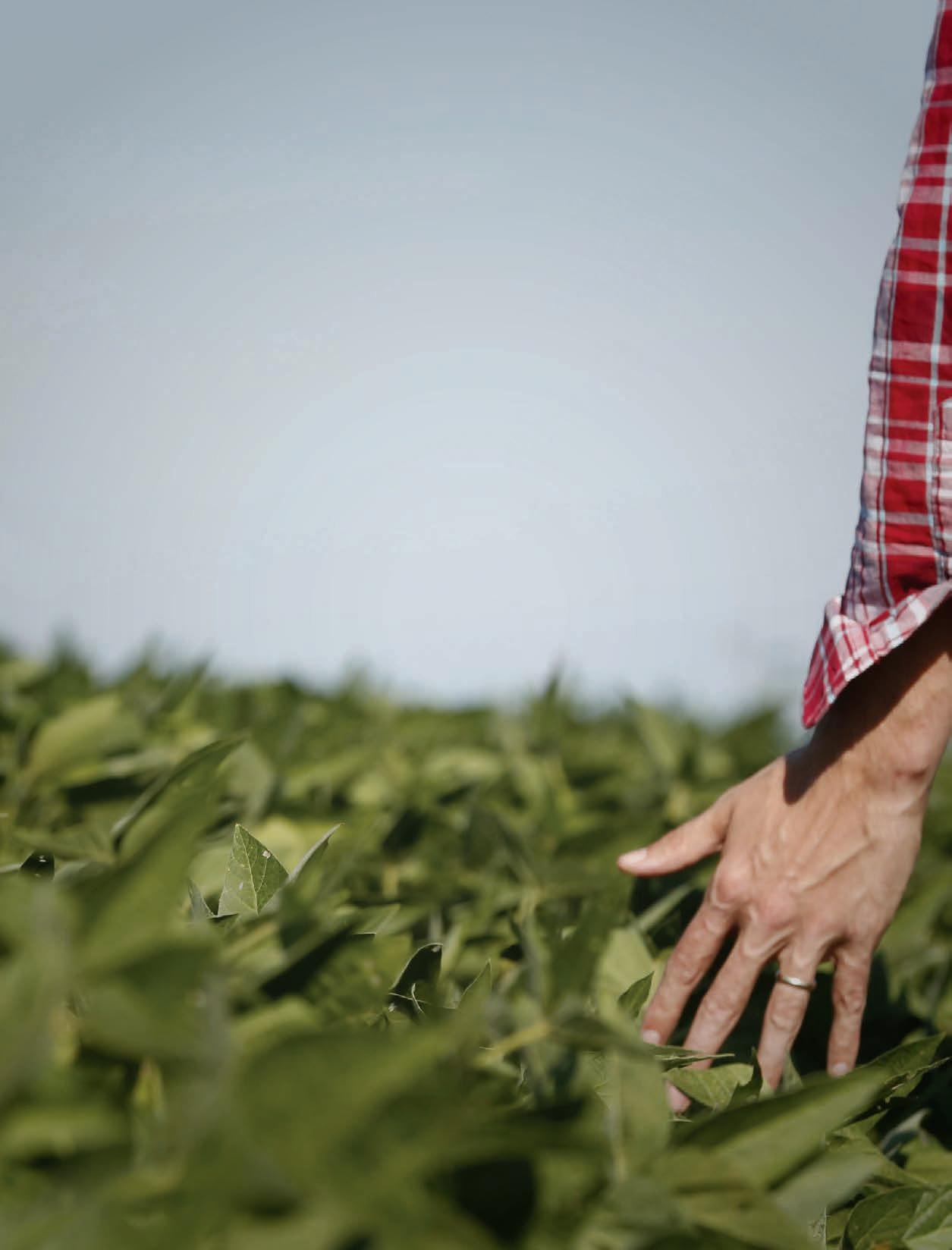



At the time of publication, the United States is currently facing the COVID-19 pandemic, which for much of the country includes some kind of stay-at-home order. While we know the threat of a pandemic like COVID-19 will eventually pass, social distancing reminds us of the many ways to remotely contact elected officials so you can continue to advocate from comfort of your own home (or even tractor).
Research Your Representative
It’s important to understand your representative before attempting to contact him/her. Visit www. legislature.ohio.gov and house.gov or senate.gov to find contact information for your representatives and senators, find out which legislators sit on which committees and see voting histories for your representatives. This will help you to better understand who you are contacting and how best to appeal to them.
Calling your representatives is probably the easiest and most immediate way to communicate with your legislators. For state legislators, phone numbers can be found at www.legislature.ohio. gov. For Congress, you will call the Capitol switch board (605-773-3251). If you are calling the switch board, it’s important you know the district you live in and the name of the legislator you want to contact. You likely will not be connected directly with your legislator, so it is important to plan what you will say ahead of time. Remember to state the bill number you are calling about and what action you would like your legislator to take (for example: “please vote no on HB XXXX!”). It’s also important to thank whomever you talk to.
Letters and emails can be incredibly effective ways to communicate with legislators. Handwritten letters always receive more attention than pre-printed materials. If you are writing about a general inquiry or topic, taking the extra time to send a physical letter may be worth it. When it comes to deciding between email or letter, consider the urgency of the matter. If you are writing concerning a pending vote, email is your best option as security screenings may delay receipt of a physical letter by up to three weeks. What happens to emails and letters once they arrive?
A legislative correspondent reads the messages and verifies if the sender is a constituent. Messages are then routed or tallied:
Important or compelling correspondence is given to a legislative assistant.
Unique and moving messages are shared with the member of Congress.
A summary of emails and letters received is given at an issue briefing before a vote.
Other letter writing tips:
All elected officials need to be addressed as “The Honorable _______.”
Keep it brief. Letters should be no longer than one page and should be limited to one issue.
In the first paragraph, tell your legislators that you are a constituent and identify the issue about which you are writing. If your letter pertains to a specific piece of legislation, it helps to identify it by its bill number (e.g., H.B. ____ or S.B. _____).
Choose three points that you believe will be the most effective in persuading your legislator and focus on them.
Personalize your letter by telling

Under normal circumstances, representatives of OSA meet with legislators in person to advocate on behalf of soybean farmers, like with Sen. Rob Portman. During the COVID-19 pandemic, OSA used the same tactics that farmers can use at home to interact with their elected officials.
your representative why this legislation matters in his/her community or state. If you have one, include a personal story that shows how this issue affects you and your family.
Personalize your relationship: Have you ever voted for this elected official? Have you ever contributed time or money to his or her campaign? Are you familiar with her through any business or personal relationship? If so, tell your elected official or his staff person. The closer your legislator feels to you, the more powerful your argument is likely to be.
Remember that your legislator's job is to represent you. You should be courteous and to the point, but don't be afraid to take a firm position. Remember that often your elected official may know less – especially when it comes to how farms operate.
If you use social media, that can be another way to effectively communicate with legislators. Following your representatives on social media allows you to see the issues that they are currently concerned with and reply to them quickly and easily. For social media, make sure you keep things brief and polite. You’ll also be more likely to be seen if you interact with a representative’s social media on a regular basis. u


The American Soybean Association (ASA) is celebrating its 100th Anniversary in 2020. Did you know that in those 100 years, Ohio has had six ASA presidents? You could be the next ASA president from Ohio, but first you have to be a member. Visit www.soyohio.org/membership to join or renew your membership.

J.B. Park Columbus 1937–1938

G.G. McIlroy Irwin 1938–1941

David G. Wing Mechanicsburg 1941–1943

John Sawyer London 1957–1959

Tony Anderson Washington Court House 2000–2001

Rob Joslin Sidney 2009–2010








The Ohio Soybean Council works closely with The Ohio State University to keep you on the leading edge of soybean production. Your success is the mission of OSU’s Center for Soybean Research. You have a voice there, too. When growers asked if fertilizer amounts used two decades ago were still relevant in today’s fields, OSU’s researchers went to work to find the answer.

Find all the ways the Ohio Soybean Council and the soybean checkoff work for you at OhioFieldLeader.com.






Ryan Rhoades, OSA President
What would you pay to spend more time being with the people you love and doing the things you love? Advocacy is an incredibility important civic duty and when it's time to call in the troops, we need our members to mobilize. But advocacy can also mean long hours sitting in a committee to present your testimony or waiting three hours to talk to your representatives for five minutes. The Ohio Soybean Association (OSA) exists to represent you in these situations, so you can spend your time where it’s needed most — with your family and your farm.
1
What does it mean to you to know that other farmers are fighting for your interests on your behalf?
For myself, it means a lot when other farmers are in Washington advocating on behalf of their fellow farmers. It not easy and sometimes, frankly, it is not fun — running around trying to make meetings where you sometimes have only 15 minutes to argue for all your issues. I’m glad farmers have OSA to do that because my time is valuable, and I can't be everywhere all the time. I have to prioritize, like we all do, and OSA does an incredible job prioritizing issues for soybeans farmers so I don’t have to all the time.
2
How have you seen member dollars being put to good use? What’s the ROI for membership dues?
I have seen a great return for our membership dues, especially in the area of trade. We pushed hard to restore our relationship with China and continue our relationship in a responsible way that would benefit both countries. But

as time went on without a trade deal, our incomes were affected. As a result, we saw an MFP payment that resulted in a $1.65/bushel. Other commodity organizations didn't see that level of return back to farmers for the trade losses we all suffered. The American Soybean Association (ASA) and OSA put a lot of time and energy advocating for farmers who were left in a financial slump to have some type of restitution that would help sustain us through another year. Basically, my three-year membership of $205 went toward providing $99 an acre (60 bu/a average) from the trade MFP. In other words, without MFP happening an additional $99/acre left the farm.
3 Are you a member of any other organizations that advocate specifically on soybean farmers’ behalf? What makes OSA unique? What makes OSA unique is that at the end of day it is all farmer-driven advocacy and policy-led discussions at
My fellow farmers and I meet with legislators like Congressman Bill Johnson to advocate for policies that will benefit and support the soybean industry.
every level of government to not only increase our bottom line but to make our farm operations management run more smoothly on a daily basis. OSA works on issues from water quality to fuel standards, trade, transportation, etc. Anything that could be to the determinant of soybeans or the soybean grower, OSA is there first working toward a long-term solution.
4
What would you estimate it would cost you to be away from your farm for a day to go by yourself to advocate on Capitol Square/Hill?
I am by no means a wealthy man, but I value my time at $40/hr. That said, for


myself to leave for D.C. on my own and advocate would be nearly financially impossible as well as generally inefficient. We all know that when we fight for something, we have strength in numbers. Two full days off the farm for 12-hour days would be $960. I would estimate other costs for things like fuel ($58), plane tickets ($150200), hotel ($250), Ubers/taxi ($50), and food ($100). For myself to go to D.C. and advocate for two days would be nearly $950 and I am probably forgetting a few minor costs along the way. It’s not cheap!
5Why is OSA needed now? What kind of challenges are facing soybean farmers that can be helped or solved by working with the government?
With an uncertain economy, a stressed relationship with all our trading
partners, and the continued battle with phosphorus and other nutrients in the Western Lake Erie watersheds, 2020 will be another challenging year for Ohio soybean farmers. The H2Ohio initiative, where farmers and government are working together to improve our water quality, will be rolled out this year. In addition, infrastructure like roads and bridges need repair or replacement. All of these challenges are priorities for OSA when we go talk to legislators and industry partners.
OSA is needed more than ever because our farm gate prices are falling precipitously every day and regulation, fear/uncertainty, trade issues, transportation issues, etc., are growing. Without OSA, a soybean grower could not be 100 percent dedicated to his/her farm AND advocate at the Statehouse or D.C. with 100 percent dedication. OSA
is the “squeaky wheel that gets the grease.” We’re working to solve all the issues related to soybeans and to soybean growers. We simply cannot do this on our own with this level of intensity. That is why the OSA is needed now more than ever.
Last year, OSA was able to meet with over 50 legislators and legislative staff at the state level alone, which helped keep Ohio’s soybean farmers at the forefront of discussions when it came to things like H2Ohio and the Beginning Farmer Tax Credit. Meeting with that many people is something I simply could not do on my own.
When I think about the time I save, I think about how I can spend it being a father, a husband, a farmer, and a businessman. Is an $80 membership worth it to you? Is a $205 membership worth it? It is to me. Join and renew online today at www.soyohio.org/membership. u



Last fall, the U.S. Soybean Export Council (USSEC) established a new award to build awareness of the U.S. Soy Sustainability Assurance Protocol (SSAP) in the Japanese soy industry. The inaugural prize was presented to importer Saitama Ryokoku at the November 2019 U.S. Soy Buyers’ Outlook Conference in Tokyo.
Saitama Ryokoku is a pioneer in Japan for its early sustainability focus and is the fi rst company in the world to request a SSAP-certified soy oil-based concrete form release agent, used for the construction of Tokyo’s main Olympic stadium and athletes’ village for the 2020 summer games, which have now been postponed to summer 2021 due to COVID-19 concerns. The company has imported non-GMO soybeans from Schwartz Farm (Trumbull County) for more than 20 years for use in soyfoods and has brought many Japanese soy food manufacturers to visit Ohio and the United States for USSEC trade missions, programs, and conferences such as United States Soy Global Trade
Exchange. Saitama Ryokoku influenced other Japanese customers’ belief that sustainability is an important selling point for their products, who then began using the Sustainable U.S. Soy (SUSS) logo on products exported to the European Union.
Koi Aihara accepted the award on behalf of Saitama Ryokoku. Aihara is the son of Saitama Ryokoku's president and lived in Ohio for several years. u

Katie Bauer, Ohio Soybean Council (OSC) Global Demand & Market Development Coordinator, Koi Aihara, Bill Bayliss, OSC board member and Davie Stephens, former American Soybean Association president, after presenting the U.S. Soy Sustainability Award.



JOIN US AT THE
JULY 29 - AUGUST 9

The Ohio Soybean Council will be at the Land and Living Exhibit in the Nationwide Ag & Hort Building.
Come learn more about how the Council invests your checkoff dollars to grow your profitability.



The Ohio Soybean Council Foundation (OSCF) is pleased to announce the 13 scholarship recipients for the 2020–2021 academic year.
This is the 13th year for the OSCF Scholarship Program, which was created to encourage undergraduate students to pursue degrees in one of the many academic fields that support the future of the soybean industry, including agriculture, business, communication, economics, education, science and technology, as well as to support ongoing graduate-level research. Since 2008, the OSCF scholarship program has awarded over $390,000 in scholarship funds to students studying agriculture or a related field at Ohio colleges or universities.
“I want to congratulate our 2020–2021 scholarship recipients,” said Bill Bateson, OSC board chairman, soybean farmer from Hancock County and scholarship selection committee member. “It seems like each year our decision is made more difficult because of the incredible talent and dedication to agriculture these students have.”
A $3,000 undergraduate scholarship was awarded to:
Kevin Fruth of Fostoria, Ohio, a junior at the University of Toledo studying chemical engineering.
Chyann Kendel of Eaton, Ohio, a sophomore at Wilmington College studying animal science and education.
Wyatt Kissell of Mount Vernon, Ohio, a freshman at The Ohio State University studying agronomy.
Alex Kutz of Valley City, Ohio, a junior at The Ohio State University studying agricultural systems management.
Sarah Lehner of Delaware, Ohio, a junior at The Ohio State University studying animal sciences and agribusiness and applied economics.
Holly Schmenk of Leipsic, Ohio, a sophomore at The Ohio State University studying animal science and agribusiness and applied economics.
Jacob Wuebker of Versailles, Ohio, a sophomore at Wright State University studying agricultural business.

The Robinson W. Joslin Scholarship, an annual $3,000 scholarship created to honor Robinson Joslin, a long-time leader in the soybean industry both in Ohio and nationally, who passed away in May 2016, was awarded to:
Courtney Heiser of Attica, Ohio, a sophomore at The Ohio State University studying agricultural communication.
The annual $5,000 Bhima Vijayendran Scholarship, named in honor of a Battelle research scientist who has made tremendous contributions to the soybean industry, was awarded to:
Anna Tobler of Galloway, Ohio, a junior at The Ohio State University studying chemical engineering.
A $2,500 graduate scholarship was awarded to:
Asritha Nallapaneni of India, who is pursuing her doctorate in polymer engineering at the University of Akron. Her research consists of developing a multi-functional coating with polymers derived from soybean oil.
Blaire Volbers of Cleveland Heights, Ohio, who is pursuing her doctorate in chemical engineering at Case Western Reserve University. Her research consists of developing highervalue products from raw soybeans, including the oil, meal and leftover plant matter. Her research will also include creating lesson plans for high school students that demonstrate how local crops such as soybeans can be processed into other products.
A $5,000 graduate scholarship was awarded to:
Tu Huynh of Vietnam, who is pursuing her doctorate in horticulture and crop science at The Ohio State University. Huynh is studying the genes that control oil and protein components in soybeans in order to breed soybeans with better composition without sacrificing yield.
Christian Vargas Garcia of Puerto Rico, who is pursuing his doctorate in plant breeding and genetics at The Ohio State University. His research focuses on breeding soybeans that are resistant to phytophthora root rot. His hope is to allow farmers to decrease their input costs for fungicides while meeting consumer demand for reduced use of chemicals in farming. u






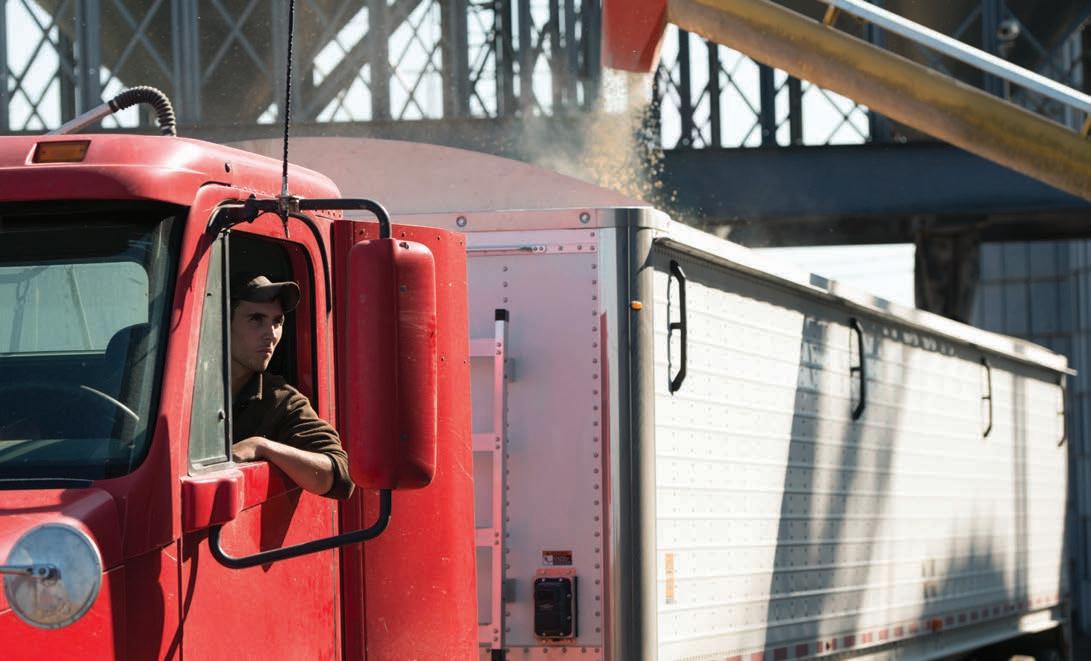
Should I deliver my soybeans or grain to the local elevator offering a more modest price or the more distant market offering a premium price?
Where should I deliver my soybeans or grain?
Farmers must not only be mindful of the price received, but also the costs associated with the delivery. After all, the goal is to maximize profit vs. maximize revenue.
The calculator works for soybeans, corn, wheat and other commodities. In a few short steps, farmers can determine not only how much money will be received but also how much will be spent.
Search for “Soy Transportation Coalition” or “STC Calculator” on the App Store or Google Play. The calculator can also be accessed online at www.soytransportation.org/calculator







By: Dusty Sonnenberg, CCA
With prevent plant acres abundant in 2019, some fields experienced a huge increase in the weed seed bank. For some of those fields, pre- and postherbicide applications were delayed, or did not occur at all. In other fields, weed control was attempted by mowing and tillage prior to seed development. For 2020, weed management could be a challenge.
“This is one of those times you do not want to cut out any of your preherbicides or cut rates on your post-,” said Mark Loux, Ohio State University Extension weed scientist.
The three primary weeds of most concern coming out of the 2019 prevent plant acres include: waterhemp, ragweed and marestail.
“Farmers need to be sure to have a comprehensive effective herbicide program that includes: effective burndown or tillage, a full rate of preemergence herbicide with residuals, and choosing an effective post emerge soybean trait system,” Loux said.
If tillage is planned, multiple tillage passes spaced a few weeks apart will stimulate additional emergence, and each new set of weeds can be taken out by tillage. If farmers are going to use a moldboard plow to flip the soil and weed seeds deep, they should not flip it again. The weed seed should be left buried deep. If shallow tillage is used, it will bury some weed seed for the current year, however the next shallow tillage pass will bring some of them back up to the surface.
No-till is another option to leave the weed seed on the surface and control it with herbicide applications. The downside to this is the longer a farmer waits to spray, it creates a more difficult



burndown situation in no-till fields if the weeds get too big. Oftentimes, however, the seed will emerge sooner and degrade faster if left on the surface.
Every weed species is different, and the seed production and seed longevity is unique. A single giant ragweed plant can produce 5,000 seeds, and those seeds can be viable for up to 4 years. A marestail plant can produce 200,000 seeds and they can be viable for up to 4 years. A redroot pigweed can produce 229,000 seeds and be viable for up to 40 years. Palmer amaranth and Waterhemp can produce up to 1 million seeds in a single year, and they can be viable for up to 4 years.
Loux shared some tips for preventing Palmer amaranth and waterhemp from getting out of control.
“Use residual herbicides as your first line of defense,” Loux said. “Know what the weeds look like, and scout fields from late July through September. If needed, request help for proper identification. Look for mature plants and mature seed, and remove the
Palmer amaranth and waterhemp plants from the field to prevent the spread of the seed, rather than running them through the combine.”
When choosing a soybean trait, farmers should evaluate how much of a problem specific weeds are, such as marestail, giant ragweed, waterhemp, Palmer amaranth, and common ragweed. “LibertyLink, LibertyLink-GT27, Extend, and Enlist are all excellent programs for marestail, Giant ragweed, and common ragweed. They rate as good for waterhemp and Palmer amaranth,” Loux said. “The Roundup Ready programs now have a lot of holes when it comes to glyphosate resistance in many of the rogue weeds. It is important for farmers to use different modes of action in a comprehensive herbicide program to slow the development of resistance to these other herbicides.” u





For more than 20 years, greater than 95 percent of all SCN-resistant soybean varieties have included resistance from the PI 88788 breeding line.
Nematodes are becoming “resistant to the resistance.”
TOO MUCH of a good thing. AS SCN REPRODUCTION INCREASES, yields decrease by as much as 14 bushels per acre.
The percentage of SCN populations in a state/province with elevated reproduction (>10%) on PI 88788

A resistant variety should allow less than 10 percent reproduction. In other words, a resistant variety should stop 90 percent of the SCN in a field from reproducing. Across the region, varieties with PI 88788 resistance aren’t hitting the mark. On some farms, one out of every two nematodes can reproduce.
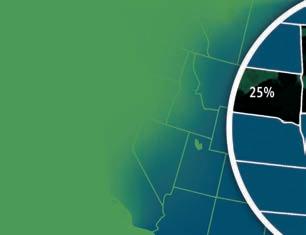

data point represents the MEAN yield of all resistant varieties with PI 88788 in a variety trial field experiment
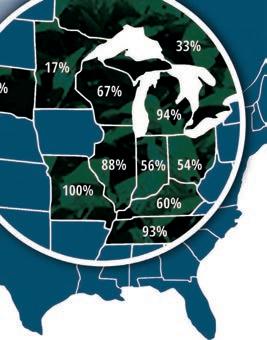
Research shows yield loss as SCN populations increase on varieties with the PI 88788 resistance source. This data is from 25 years of variety trial experiments in farmers’ fields in Iowa.
The Reproductive Factor (RF) is the end-of-season number of SCN eggs divided by the beginning-season number of eggs. An RF of 2 means SCN egg numbers doubled from spring to fall. An RF of 4 means egg numbers quadrupled. The last data point on the far right in the graph has an RF of almost 40 (a fortyfold increase).


recommendations.

• Test your fields to know your numbers.
• Rotate resistant varieties.*
• Rotate to non-host crops.
• Consider using a nematode-protectant seed treatment. Work with your advisors and develop a plan to manage SCN:




SCN populations can adapt to individual resistant varieties as well as to sources of resistance such as PI 88788 and Peking. So, rotating to a


Visit TheSCNcoalition.com for more information.











By: Julia Brown
hen it comes to plant research, one could argue that on-farm is the best way to conduct applied research. On-farm research offers the opportunity to test techniques, genetics and chemicals in a practical setting. The Ohio Soybean Council (OSC) and soybean checkoff invests in on-farm research projects at both the state (The Ohio State University [OSU]) and regional (North Central Soybean Research Program [NCSRP]) levels to help farmers grow a better bean.
Some of the projects that OSC invests in are part of OSU’s eFields program, which focuses on precision
“On-farm research, in my opinion is the best way for a farmer to know how a practice or a technology is going to work on their farm and what the return on investment could potentially be for that technology or practice,” said Elizabeth Hawkins, an OSU field specialist in agronomic systems. Hawkins works extensively on the eFields program, mostly with seeding rate trials and nutrient trails.

Keith Kemp, a former Ohio Soybean Council board member and farmer from Preble County, spoke to NCSRP researchers about the research being done on his own farm.
She explained that on-farm research is an extension of the other research being conducted at OSU. “There are always

nutrient management strategies and technologies to improve efficiency of fertilizer placement, enable onfarm evaluation, automate machine functionality, enhance placement of pesticides and seed, and to develop analytical tools for digital agriculture.
going to be variables that we can control in a university trial that we can’t in an actual farm setting,” Hawkins said. “Onfarm research helps us to work through those wrinkles and truly understand what’s going to work on their soil types and their other management practices.”
“It’s a hands-on thing and that’s really what’s neat about it. A lot of private companies put their test plots on their best soils, but I want to see it on my farm, my soil, my conditions.”
Kemp served on the NCSRP board for several years. Some of the on-farm projects featured in e-Fields are funded by NCSRP.
As with any research, the eFields project is not a one way street. “We want the things that we’re addressing in eFields to really be tailored toward the types of questions that the farmers in Ohio need answers to so we’re always open to getting feedback on what that next trial should be,” Hawkins said.
Interested in learning more about the checkoff-funded on-farm research conducted by OSU? Check out these projects in the 2019 edition of eFields:
Fungicide and Insecticide — page 104
Insecticide — page 108
Planting Date, Fungicide, Insecticide — page 114
Sulfur — page 132
Soybean Yield by Planting Date — page 136 (NCSRP project)
Seeding Rate Trials — pgs. 139 and 144
SCN Coalition — page 198 (NCSRP and SCN Coalition project)
To learn more about the eFields program, visit digitalag.osu.edu/efields More information about NCSRP can be found at ncsrp.com u


Because of your investment in education through checkoff dollars, Ohio teachers have access to resources allowing them to provide online education during the COVID crisis. GrowNextGen, the Ohio Soybean Council’s (OSC) educational initiative, has created a Virtual Resources collection for distance learning.
This collection includes curriculum and activities covering a variety of topics for students from kindergarten through high school. Unit topics include:
animal nutrition
aquaculture
bioproducts
a Chickquest primer, animal agriculture
commodity transportation
food science and food science careers
growth and development of pigs
H2Know digital case study
international trade in agriculture
pH in soil
water quality and more
The Virtual Resource Collection is a great way to introduce new teachers to all GrowNextGen has to offer, converting them to lifetime users of the free resources that OSC’s investment provides. This content collection was promoted to our entire teacher network, increasing the GrowNextGen site traffic by 190%.
The Ohio Soybean Council has been investing in teachers through GrowNextGen for many years, with a goal of growing the next generation of entrepreneurs and leaders for the changing industry that feeds the world. GrowNextGen was created with the help of the OSC's education partner, EducationProjects.org, and has reached over 14,000 Ohio teachers and


provided over $750,000 in classroom supplies since its launch in 2014.
This educational initiative provides teachers with free, high quality STEM units and lessons that bring agriculture principles and practices into the classroom. The site also includes e-learning courses (Modern Agricultural Practices, Food Science and Technology, and more) and a network of educators and industry leaders to answer questions and provide resources to support the lessons. Career videos and discussion guides describing career pathways allow teachers to give students a look into multiple careers they might not have considered. Virtual field trips, created in partnership with Shift•ology Communication, provide a firsthand experience of planting and harvesting, as well as information about soybean uses and roles in global trade.
Get involved! We’re looking for industry leaders like you to share your knowledge with our vast network of educators throughout Ohio. Upcoming events include the Ag Biotech Academy summer workshop (https:// grownextgen.org/events/ ag-biotech) for teachers of biology, chemistry, and environmental science. This professional
development event introduces teachers to biotechnology methods and the ways these methods are incorporated into agriculture through food science and biofuels labs. A valuable part of this event is the industry dinner which allows teachers to talk with farmers and hear about the challenges they face.
During the 2020–2021 school year, we will also provide several ChickQuest workshops around the state. This popular program includes STEM activities and hatching eggs in the classroom, helping students understand more about animal agriculture, egg production in Ohio, and how Ohio soybeans feed chickens.
Sign up for our newsletter at grownextgen.org to stay up to date on how your investment enables the Ohio Soybean Council to support teachers in your community. u




By: Julia Brown
When something on your farm needs a little grease, you probably reach for that trusty blue-and-yellow can of WD-40 — it’s a common product on most farms and in most homes across the United States. It’s so common that the brand name has come to stand for the product itself, like Kleenex. You’d never hear someone say, “Pass me that can of penetrating oil.”
Now imagine that same product that sits on a shelf in every American home contains soybean oil. That type of product is already in the works at Airable Research Lab, the Ohio Soybean Council (OSC) and soybean checkoff’s recently-
founded research and development business venture. Airable works to incorporate soy into existing products to address product challenges. For example, soybean oil can often replace petroleum ingredients, such as the oils and solvents found in WD-40, resulting in a greener and less expensive product. The lab researchers also develop their own soybased innovations.
“A considerable number of products that are household items
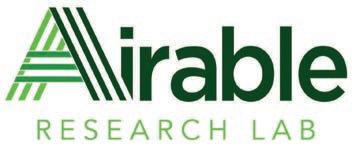
have been around since long before we fully understood the potential harm associated with some of their additives,” said Barry McGraw, Airable’s founder and chief laboratory officer.
“We’re finding more and more ways to replace those elements with soybean components. Not only are soybeans earth-friendly, they’re abundant and locally sourced; when compared to petroleum, soybeans make all kinds of sense in terms of economics.
“Buying more soybeans for production helps the local farmers, too,” McGraw added.
Airable is working with Dynamic Green Products (DGP), a Texas-based company that focuses on creating
environmentally friendly alternatives for lubricants and cleaners. The Airable–DGP connection began at Ohio Wesleyan University, where Airable is housed, when McGraw struck up a conversation with Robert Holmes who leads marketing for DGP. They began to talk about the company’s many products, including a WD-40like Multi-Use & Penetrating Oil, and McGraw saw an opportunity.
“The relationship is mutually beneficial,” said McGraw. “DGP is exactly the type of partner that we seek: a forward-thinking company looking to transform yesterday’s products for today’s marketplace. DGP provides the challenge, and Airable comes up with the soy-based solution. It’s a win-win, and I’m excited about the prospects — for the penetrating oil and for the future.”
OSC has a long history of improving product formulas that already use soy or working soy into products where there is none. One of the best examples is Roof Maxx, a company that was already using soy in its roof rejuvenation product but was able to improve the formula with help from OSC. Roof Maxx is now one of the fastest-growing franchises in the country.
“We know that more and more, consumers are looking for green products to use in their homes," said Todd Hesterman, Henry County farmer and OSC research committee chair. "Soy is really poised to fill that need, which helps drive more demand for our product.”
Holmes also sees the collaboration as working to DGP’s benefit. The company’s founders were salespeople, not scientists, but were willing to try new things and weren’t tied down to the way things have always been done. They had already developed their Multi-Use & Penetrating Oil before partnering with Airable but decided to try integrating soy.
The oil’s formula now uses up to 85 percent soy methyl ester, and it works just like WD-40 to penetrate rust and prevent corrosion, all without toxic vapors that are often associated with


petroleum-based products. Holmes also sees the product benefitting the farmers who provide the soybeans to make it — not only indirectly (through increased soybean consumption) but also directly (through hands-on use). If a tractor or other piece of equipment needs lubrication in the field, the multi-use oil is the perfect solution because it won’t harm soil or plants if it’s spilled.
“If a farmer is out in the field and a line bursts, that’s going to impact the soil,” said Holmes of traditional oils and lubricants. “Everything that DGP creates is ultimate-biodegradable, meaning it will biodegrade 60 percent or more in less than 28 days.”
He went on to explain that about 200 million gallons of oil is disposed of improperly or leaked throughout the year in the U.S. alone. “Petroleum-based products take a long time to biodegrade — up to 10 years. The goal of the company was to develop products that would use a plant-based oil.”
But can a plant-based product hold up to its petroleum-based competitors? In fact, DGP based its testing of Multi-Use & Penetrating Oil against WD-40 and has shown that the bio-based product outperforms the traditional oil in many circumstances. And the addition of soy isn’t just adding soy for the sake of adding soy — according to Holmes, soy helps improve product performance.
This comes as no shock to McGraw, who knows that soy makes competitive
products. “Soybean oil has been boosting manufacturing since Henry Ford developed the car part,” said McGraw. “The plant’s components are remarkably versatile.”
After a long day of using the Multi-Use & Penetrating Oil on the farm, your hands probably feel a little grimy. DGP has a soy solution for that, too. The company’s Bio-based Hand Wipes, which use 55–65 percent soy methyl ester and a certified biobased wipe material, are effective on tough substances such as paint, tar, sap and oil. The soy ingredients also help keep skin feeling moisturized.
“Soybean oil is composed primarily of fatty acids like those found in human skin,” said McGraw, “as well as containing nurturing nutrients. I think you’ll find, if you check out the cosmetics section, that more and more creams and moisturizers contain soy.”
Similar to the penetrating oil, the hand wipes work just as well, if not better, than competitors seen in big box stores. Both the Multi-Use & Penetrating Oil and the Bio-based Hand Wipes are registered under the USDA BioPreferred program, with certification in process.
The USDA Certified Biobased Product label is designed to provide information to consumers about the biobased content of the product. The label assures a consumer that the product contains a USDA-verified amount of renewable biological ingredients.
“One of the reasons we’re creating biobased products is that we want to be a purposeful organization that’s doing the right thing for the Earth. And we know farmers have that mindset.” Holmes added that the company is looking into other products that can benefit from the addition of soy.
To learn more about the Bio-based Hand Wipes, Multi-Use & Penetrating Oil, and the other products DGP has to offer, visit dgpworks.com. You can also learn about what products are being developed with your soybean checkoff dollars at airableresearchlab.com. u




“THE CHECKOFF IS ABLE TO INVEST IN GROUPS THAT PROMOTE BIODIESEL. BY INVESTING IN THESE GROUPS, IT DRIVES THE DEMAND FOR SOYBEANS IN OHIO. THE CHECKOFF INVESTMENT HAS A DIRECT IMPACT.”


BY INVESTING IN THE SOYBEAN CHECKOFF AND WORKING WITH THE OHIO SOYBEAN COUNCIL, SOYBEAN FARMERS CONTINUE TO GROW THE DEMAND FOR BIODIESEL WHILE RAISING SOYBEANS PROFITABLY. BIODIESEL DEMAND INCREASES SOYBEAN DEMAND. BIODIESEL DEMAND ALONE HAS PROVIDED FARMERS AN INCREASE IN PROFITS OF 63 CENTS PER BUSHEL.
TO YOU BY
LE ARN MORE AT SOYOHIO.ORG /HERE WE GROW.